History of Oriental carpets

When one speaks of carpets that are not only functional but also rich in history, art, and culture, the name "Azerbaijani carpets" often comes to mind. These stunning works of art originate from Azerbaijan, a country with a deep-rooted weaving tradition that stretches back centuries. Known for their intricate patterns, vibrant colours, and exceptional craftsmanship, Azerbaijani carpets are far more than just floor coverings; they are a reflection of a civilization's soul and its artistic heritage.
The artistry of Azerbaijani carpets is evident in their detailed designs, which often feature motifs inspired by nature, geometric patterns, and elements of daily life. Each carpet is woven with skillful hands, preserving not only a craft but also the stories and legends of the artisans who create them. The designs can vary from region to region, each offering its own distinct styles and techniques that reflect the unique culture and history of the area.
Azerbaijani carpets are a true testament to the rich cultural heritage of the region. For centuries, the craft has been passed down through generations, and the carpets themselves are considered highly prized possessions, sought after by collectors and connoisseurs worldwide. Woven with care and devotion, these carpets are a living testament to the legacy of Azerbaijani artistry and craftsmanship, embodying the essence of the culture they come from.
The first mentions of oriental carpets
The annals of history are filled with references to the renowned Azerbaijani carpets, which have long held a prominent place in global culture. The earliest recorded mention can be traced back to the medieval period, particularly during the Seljuk Empire, around the 11th century. Historical texts and travelers' accounts from the time describe the richness and exceptional craftsmanship of Azerbaijani carpets, highlighting their role in the décor of royal courts and grand homes across the region. These carpets were often sought after for their intricate designs, vibrant colours, and the unmatched skill of the artisans who wove them. Over the centuries, the tradition of carpet weaving became an integral part of Azerbaijan's cultural identity, with each region developing its own distinct patterns and techniques. The artistry behind these carpets continues to be celebrated and cherished today, making them a symbol of Azerbaijan’s rich heritage and craftsmanship.

Moreover, the famous Pazyryk carpet, discovered in a Scythian tomb in Siberia and dated to the 5th century BC, provides tangible evidence of the ancient craft. While its origins continue to spark debate among historians, its intricate designs and knotting techniques bear a striking resemblance to those seen in Azerbaijani carpets. This connection highlights the shared weaving traditions that have existed across regions for millennia.
As trade routes expanded and cultures began to intermingle, the reputation of Azerbaijani carpets spread across continents. Through the Silk Road and other trade networks, their intricate craftsmanship became known far beyond the Caucasus region.
By the time of the Seljuk Empire (11th to 14th centuries), Azerbaijani carpets had earned a place not only in art and literature but also as prestigious diplomatic gifts. These exquisite creations were highly valued for their artistry and skill, symbolizing the wealth and cultural sophistication of the region.
The period of development of Carpet weaving
Mongols and Tatars: nomadic intertwining with artistry
The seismic cultural shifts brought on by the Mongol invasions of the 13th century, led by towering figures like Genghis Khan and his successors, were pivotal in the history of Azerbaijani carpets. These invasions, which reshaped much of Central Asia and the Middle East, brought new influences to the region, blending various artistic and cultural traditions.
As the Mongols established their empire, they absorbed the rich artistic heritage of the regions they conquered, including the intricate carpet weaving traditions of Azerbaijan. This fusion of styles gave rise to new design elements and techniques, further elevating the status of Azerbaijani carpets in the world. The resulting masterpieces were prized not only for their exceptional craftsmanship but also for their ability to incorporate a range of artistic influences from across the empire, cementing their place in the broader history of carpet weaving.
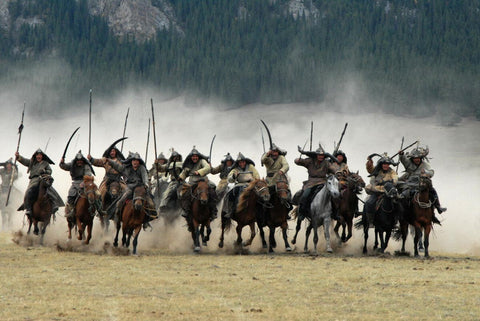
Establishing the Ilkhanate in Azerbaijan, the Mongols incorporated their own sensibilities, which were then fused with the rich, established craftsmanship of Azerbaijani weavers. This period marked a significant shift in the evolution of Azerbaijani carpets, blending Mongol artistic influences with the intricate techniques of local artisans.
Carpets from this era began to feature a distinctive mix of dragon motifs, geometric patterns, and other symbolic elements associated with Mongol and Tatar cultures. There is speculation that some carpets incorporated "phoenix-dragon" designs, potentially influenced by Mongol exposure to Chinese symbology, reflecting the vast cultural exchange under the Ilkhanate's rule.
The blending of Mongol-Tatar artistic preferences with the fine intricacies of Azerbaijani craftsmanship gave rise to a vibrant new chapter in carpet design. This period saw bolder color palettes and more expansive motifs, signaling a departure from earlier designs and setting the stage for the evolution of Azerbaijani carpets into the masterpieces we recognize today.
Coming of Islam: Evolving Artistry Under Faith
The advent of Islam in Azerbaijan during the 7th century ushered in profound artistic transformations, shaping the future of Azerbaijani carpet design. Islamic principles, which traditionally discourage the portrayal of sentient beings in art, led to a shift in the motifs and patterns used in Azerbaijani carpets.
Rather than depicting human figures or animals, weavers began to focus on intricate geometric designs, floral motifs, and arabesques, which became a hallmark of Islamic art. This change not only aligned with religious beliefs but also encouraged the development of more abstract and symbolic representations, which elevated the aesthetic complexity of Azerbaijani carpets.
This period marked the beginning of a distinctive artistic direction in Azerbaijani carpet-making, where spirituality, symmetry, and the beauty of nature were conveyed through innovative patterns and vibrant color schemes. The carpets of this era reflect the growing influence of Islamic culture while still preserving the traditional weaving techniques that were passed down through generations.
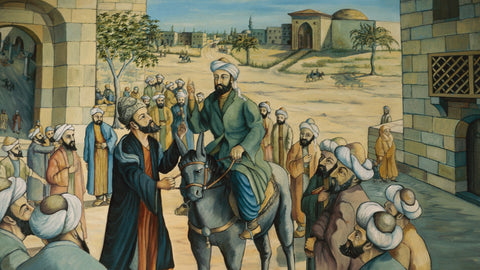
The highly figurative designs prevalent in pre-Islamic Azerbaijan gave way to abstract, geometric patterns, intricate arabesques, and floral motifs following the arrival of Islam. This shift was reflective of the Islamic emphasis on avoiding depictions of sentient beings in art, resulting in a more stylized and symbolic form of expression.
Additionally, the integration of calligraphy became a prominent feature in Azerbaijani carpets, with verses from the Qur'an often intricately woven into the designs. These calligraphic elements not only enhanced the aesthetic value of the carpets but also imbued them with spiritual significance, reflecting the deep connection between art and faith in the Islamic world.
The Seljuq Dynasty, which rose to prominence after the spread of Islam in Azerbaijan, played a crucial role in refining and fostering these artistic themes. Their influence can be seen in the carpets of the period, which featured intricate patterns and a sophisticated use of color. The artistic principles developed during this time also resonated through other forms of Islamic art, such as the tiles and motifs of the Alhambra Palace, serving as a testament to the lasting impact of Islamic culture on Azerbaijani carpet design.
Ottoman Empire: threads of rivalry and symbiosis
The clash and camaraderie between the Ottoman Empire and the Persian state in the 16th and 17th centuries shaped both empires' carpet-making legacies.
Although distinct in their styles, the mutual artistic influences are undeniable. Persian carpets, renowned for their intricate designs, spurred the Ottomans to elevate their carpet craftsmanship.

As a result, the carpet market began to see a fusion of designs inspired by Azerbaijani motifs, such as the "saz leaf" and "cloud band." These elements, which originated from Azerbaijani artistry, influenced Persian carpets, adding a touch of regional flair. Meanwhile, Persian carpets began incorporating the bold, geometric patterns favored in Ottoman territories. This period stands as a testament to the interplay of rivalry and mutual respect between two of history's most influential empires, each influencing the other’s artistic traditions while preserving their distinct cultural identities. This cross-cultural exchange helped elevate the art of carpet weaving, resulting in designs that reflect both the rivalry and the collaborative spirit between the empires.
19th Century: The western enchantment
With the dawn of the 19th century, the charm of Azerbaijani carpets captivated Western sensibilities. As Europe’s middle class and aristocracy began to grow, their taste for exotic luxury items soared, with Azerbaijani carpets becoming a symbol of sophistication and refinement. This growing demand for high-quality, intricately designed carpets led to an increase in their production, and Western markets soon became flooded with these oriental treasures. The exquisite craftsmanship, rich colors, and cultural significance of Azerbaijani carpets resonated with European buyers, further cementing their status as coveted symbols of wealth and taste.
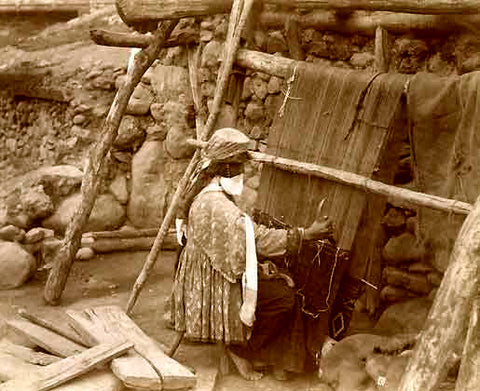
Azerbaijan's carpet-making tradition is deeply rooted in its cities, each contributing uniquely to the craft's evolution.
Baku, the capital, is a key commercial hub, benefiting from its position on trade routes. Here, carpets blend traditional Azerbaijani motifs with European influences, reflecting the growing demand from the West in the 19th century.
Ganja, another major center, is known for its bold patterns and vibrant colours. Located at crucial trade crossroads, Ganja carpets feature geometric designs passed down through generations, making them highly sought after for their striking aesthetics.
To the north, Shaki is renowned for luxurious carpets often woven with silk, combining intricate floral patterns with a smooth, glossy finish. The city’s historical silk industry has shaped these exquisite pieces into works of art.
In central Azerbaijan, Mingachevir carpets are noted for their darker tones and geometric designs, offering a unique, durable style that combines beauty with practicality.
20th Century: tradition meets modernity
The 20th century presented a plethora of challenges and evolution for the Azerbaijani carpet industry.
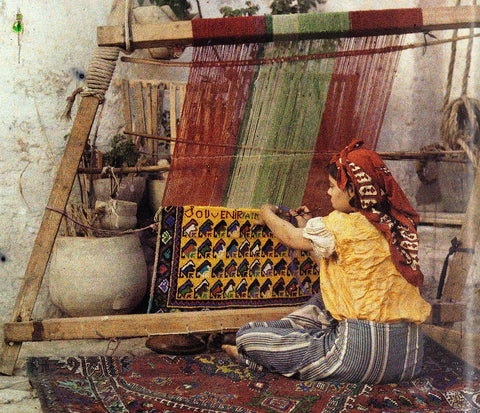
There was a concerted effort to revive traditional designs, reflecting nationalistic pride, while also accommodating modern aesthetics. Machine-made carpets also entered the fray, offering affordability but sparking debates about authenticity and value.
Nowadays: a global tapestry
In today's interconnected world, oriental carpets straddle the delicate line between tradition and contemporary tastes. The global home decor market sees a blend of classic oriental motifs alongside modern, minimalist designs.

Artisans face challenges like machine-made rug competition and economic hardships but also opportunities through online marketplaces and international exhibitions. Sustainability is a buzzword, with many weavers opting for natural dyes and ethical practices, resonating with a global audience keen on eco-friendly choices.
The Azerbaijani carpet, thus, continues its millennia-old journey, adapting, evolving, and enchanting.
Tabriz - the capital of Azerbaijani carpets
Tabriz, a historic city nestled in the northwestern region of present-day Iran, carries the legacy of being the heart of Azerbaijani and Persian carpet-making traditions. Situated in the geographical and cultural crossroads, this ancient city has long been a melting pot, blending the Azerbaijani and Persian artistry seamlessly.
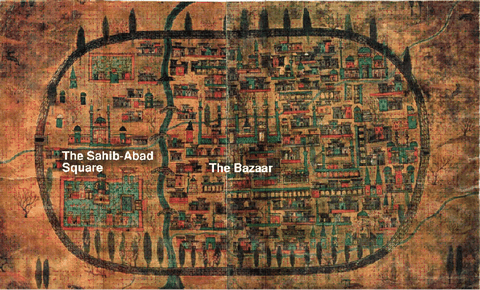
Historically, Tabriz served as the primary nexus of the Silk Road, where merchants, artisans, and traders converged, weaving together not just fabrics but stories, techniques, and cultures. This confluence enabled the evolution of a unique carpet tradition that melds the essence of both Azerbaijani and Persian aesthetics. The distinctiveness of Tabriz carpets lies in their versatility, capturing the intricate Persian motifs while embracing the robust geometric patterns often associated with Azerbaijani designs.
The workshops of Tabriz, dating back to the medieval era, were renowned for producing some of the most sought-after rugs in both the East and the West. By the time of the Safavid Dynasty, Tabriz had cemented its reputation, with royal workshops further elevating the city's status in the carpet-making world. These workshops, under royal patronage, delved deep into the fusion of Azerbaijani and Persian designs, creating masterpieces that narrated tales of shared heritages and interwoven destinies.

One of the defining features of carpets from Tabriz is the 'Tabriz knot', a hallmark of the city's craftsmanship. This specific knotting technique allowed for intricate designs to come to life, facilitating the depiction of scenes from Persian epics or Azerbaijani folktales. The typical color palette of deep reds, ethereal blues, and subtle beiges, punctuated occasionally with gold and silver threads, further accentuated the beauty of these joint heritages.
Another noteworthy aspect is the underlying theme of unity that Tabriz carpets encapsulate. Whether it's the depiction of a hunting scene reminiscent of Persian royal tales or a geometric pattern that harks back to Azerbaijani tribal motifs, the carpets stand as a testament to the harmonious coexistence of two rich cultures.
Today, as one walks through the bustling bazaars of Tabriz, the legacy of centuries-old craftsmanship is palpable. Rows upon rows of carpets, each telling tales of a shared Azerbaijani and Persian legacy, hang majestically, inviting connoisseurs and curious souls alike. They are not just pieces of art; they are woven chronicles of a city that became the beating heart of a united carpet-making tradition.
What is special about Azerbaijani carpets and how do they differ from others?
Azerbaijani carpets, a harmonious blend of two grand weaving traditions, stand out as illustrious embodiments of both Azerbaijani and Persian artistic genius. These carpets, intricately interwoven with history, culture, and craft, have certain unmistakable characteristics that set them apart in the vast tapestry of global rug-making.
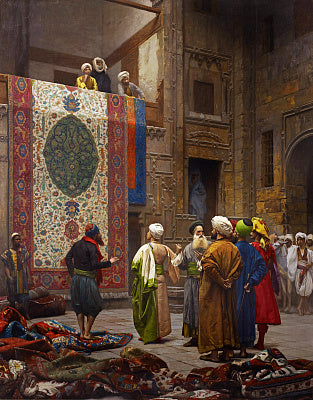
Rich symbolism and storytelling
One of the most captivating features of Azerbaijani carpets is the depth of symbolism in their designs. Every motif, whether a geometric pattern reminiscent of Azerbaijani tribal art or a floral sprawl echoing Persian gardens, tells a story. The 'buta' or paisley design, for instance, which is indigenous to Azerbaijani art, frequently finds its place alongside classic Persian motifs like the cypress tree or the Shah Abbasi flower. These designs are not mere decorations; they are visual narratives, encapsulating myths, legends, and shared cultural memories.
Unparalleled craftsmanship
The weaving techniques employed in creating Azerbaijani carpets are second to none. The precision of the 'Turkish knot' or 'Ghiordes knot', which is native to Azerbaijani carpet-making, marries beautifully with the 'Senneh knot' or 'Persian knot'. This combination allows for a denser weave and intricate designs, making the carpets durable while retaining their delicate appearance. The craftsmanship is so refined that the front and back of these carpets are often equally impressive, a rarity in the world of rug-making.
Diverse color palette
Azerbaijani carpets are celebrated for their rich and varied color palette. From the earthy tones inspired by Azerbaijan's rugged landscapes to the luminous hues reminiscent of Persian gardens and palaces, these carpets present a visual feast. The dyes, traditionally sourced from nature – roots, berries, bark, and leaves – impart a unique vibrancy to the carpets, making each piece a standalone work of art.
Distinctive borders and medallions
A trademark of many Azerbaijani carpets is the use of intricate borders enclosing central medallions. While the medallion often captures a central theme or narrative, the borders are adorned with repeating motifs, showcasing the harmonious balance between Azerbaijani geometric patterns and Persian ornate designs.
How they differ
While sharing many similarities due to their geographic and cultural proximity, Azerbaijani and Persian carpets have their distinct styles. Persian rugs are known for their detailed curvilinear designs, opulent visual narratives, and softer color transitions. In contrast, Azerbaijani carpets, especially those from tribal regions, often showcase more geometric, bold patterns and might have a more contrasting color play.
Materials from which persian carpets are made
Persian carpets, renowned worldwide for their unparalleled beauty and craftsmanship, owe much of their allure and functionality to the materials from which they are woven. These materials, meticulously sourced and processed, not only influence the carpet's appearance and feel but also its durability, value, and purpose. Among the various materials employed over the centuries, silk, cotton, and wool stand out as the primary threads interwoven into the fabric of this grand tradition.
Silk: The epitome of elegance and precision
Silk, often dubbed the "queen of fibers," holds a special place in the hierarchy of carpet-making materials. Revered for its lustrous sheen, smooth texture, and inherent strength, silk allows for a finer knot count, facilitating the creation of intricately detailed designs that are a hallmark of luxury Persian carpets.
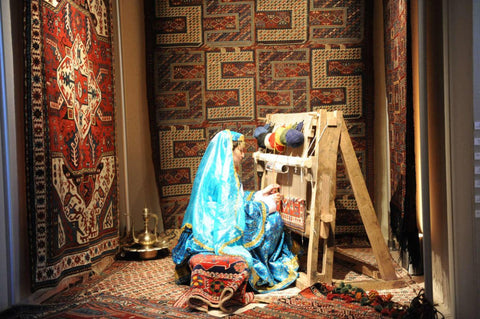
Originating from the delicate silkworm's cocoon, primarily the Bombyx mori species fed on mulberry leaves, silk threads can be dyed into a spectrum of vibrant hues. Cities like Kashan, Qum, and Isfahan are famed for their exquisite silk carpets, which often find pride of place in palaces, museums, and discerning households. However, the cost and delicacy of silk often relegate these carpets to wall hangings or areas with less foot traffic.
Cotton: The backbone of stability and durability
Cotton forms the structural backbone of many Persian carpets, especially in the warp and weft— the vertical and horizontal foundation threads. Its strength, combined with flexibility, makes cotton an ideal material to withstand tension during the weaving process and provide stability to the finished carpet. While cotton doesn't boast the same luxurious sheen as silk, its durability ensures the carpet's longevity, especially in frequently trafficked areas.
Moreover, cotton's affordability and accessibility have made it a mainstay in Persian carpet weaving centers, with some carpets, especially those for everyday use, being woven entirely from dyed cotton.
Wool: The heartbeat of tradition and comfort
Wool, sheared primarily from sheep, has been the lifeblood of Persian carpet-making for millennia. Cherished for its warmth, resilience, and natural lanolin content (which imparts a subtle sheen and dirt repellence), woolen carpets are synonymous with comfort and tradition.
Different regions in Persia, based on their climate and sheep breeds, produce varied wool quality, from the coarser types used in tribal rugs to the plush, velvety wool from cities like Kerman. Wool is incredibly versatile; it can be spun thick for plush, soft carpets or thin for tighter, finer weaves. Furthermore, wool's affinity for dyes ensures vibrancy and color longevity in woolen Persian carpets, making them cherished heirlooms passed down generations.
Weaving techniques for Persian carpets
What looms were used to weave persian carpets? The evolution of carpet-weaving technology
The artistry of Persian carpet weaving, a tradition steeped in centuries of history and culture, is underpinned by the tools that give life to these intricate designs: the looms. Over the ages, the evolution of looms, from rudimentary structures to sophisticated machines, has mirrored the advancements in carpet-making techniques and the demands of changing times.
The traditional horizontal ground loom
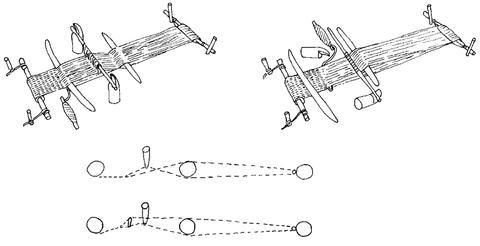
The earliest looms, prevalent among the nomadic tribes of Persia, were horizontal ground looms. Easily assembled and disassembled, these looms were perfectly suited to the nomadic lifestyle. Constructed using wooden beams, they were placed directly on the ground, with the warp threads stretched horizontally. Weavers would sit on the ground, crafting the carpet from one end to the other. These looms are particularly associated with tribal and village rugs, as their portability allowed weavers to move with the seasons, following their flocks.
The vertical loom

As societies settled and urbanized, the vertical loom emerged as the dominant tool for carpet weaving. Fixed in an upright position, often against a wall or in a dedicated workshop, this loom allowed for the production of larger and more detailed carpets. Two main types of vertical looms exist:
- Fixed Vertical Loom: A permanent structure, often found in professional workshops or urban centers, where large, intricate carpets destined for sale or trade are woven.
- Tabriz Loom: Named after the famous carpet-producing city of Tabriz, this loom features a unique mechanism where sections of the warp are released and rolled as the weaving progresses, enabling the production of extremely lengthy carpets.
The advent of mechanized looms
With the onset of the Industrial Revolution in the 19th century, mechanized looms began to find their way into the carpet-making hubs of Persia.
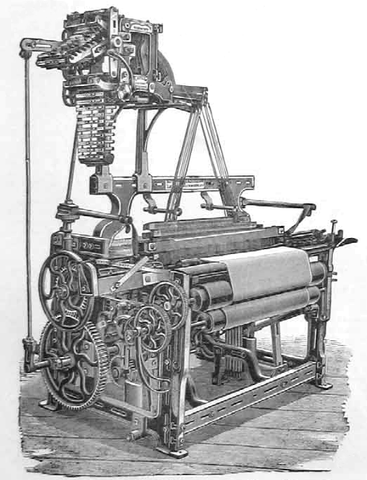
These machines, powered initially by steam and later by electricity, exponentially increased production speed and consistency. While they facilitated the mass production of carpets and brought down costs, some purists argue that they also stripped away some of the individual character and uniqueness inherent to hand-woven pieces.
The modern era: A blend of tradition and technology
In today's carpet industry, both traditional and mechanized looms coexist. While machines dominate the commercial sector, ensuring consistency and meeting the high demand for Persian-style carpets globally, traditional looms, both horizontal and vertical, continue to thrive.
They are the heart of the artisanal sector, where master weavers craft bespoke pieces, each telling its own story and carrying the essence of centuries-old traditions.
What tools were used for weaving Persian Carpets besides looms?
Ancient tools: rooted in necessity
In the early days of Persian carpet weaving, tools were fashioned from readily available materials, primarily wood and bone.
- Knives: A sharp knife has always been indispensable for cutting the yarn and trimming the pile. In the past, these were often made from bone or sharpened stones before evolving into metal variants.
- Comb-like Beaters: Made from wood or bone, these tools helped pack down the weft, ensuring a tight weave. Some ancient versions even had decorative motifs, indicative of the tool's significance in the weaver's life.
- Shuttles: Used to carry the weft yarn through the warps, early shuttles were simple wooden sticks wound with yarn, facilitating the weaving process and ensuring consistency.
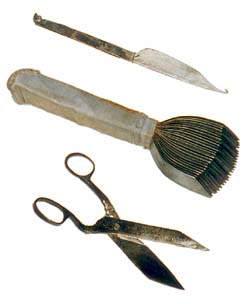
Medieval Period: refinement and specialization
As the demand for Persian carpets grew, both locally and along trade routes like the Silk Road, the tools became more specialized.
- Metal Scissors: Replacing the rudimentary knives, metal scissors allowed for greater precision when trimming the carpet's pile, ensuring a uniform finish.
- Hooks: Simplifying the process of knotting, especially for intricate designs, hooks became an integral tool in the weaver's arsenal.
- Spindles: Used for spinning raw wool, cotton, or silk into yarn, wooden spindles became more refined during this period, resulting in a more consistent yarn quality.
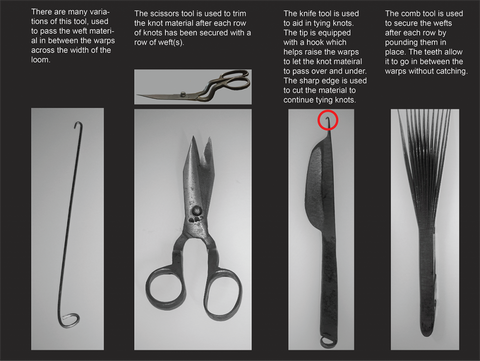
Modern Times: The confluence of tradition and innovation
While the essence of the tools remained, the 19th and 20th centuries saw subtle yet impactful innovations.
- Enhanced Shuttles: Modern shuttles are often equipped with rollers or bearings, making the passage through warp threads smoother and faster.
- Mechanical Spinning Tools: While traditional spindles are still in use, mechanical tools have emerged, ensuring faster yarn production and greater consistency in thickness.
- Advanced Scissors and Trimmers: Made from high-quality steel and ergonomically designed, these tools ensure precision cutting, which is crucial for high-end, detailed carpets.
What types of knots are used to weave Persian carpets?
In the world of carpet weaving, the heart and soul of the craft lie not just in the designs, materials, or colors, but in the very knots that bind the creation together. These knots, a seemingly simple yet profoundly intricate aspect of weaving, play a pivotal role in determining the carpet's durability, texture, and even its regional identity. Persian carpets, famed for their unparalleled craftsmanship, employ specific knotting techniques that have been passed down through generations.
1. The Persian or senneh knot:
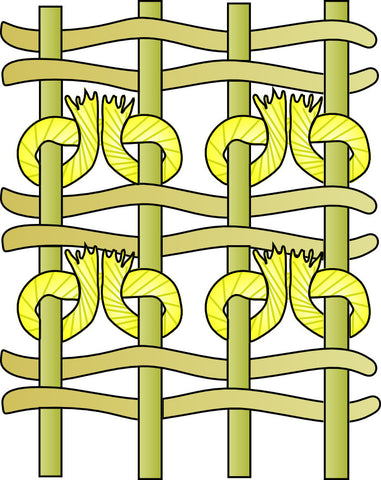
The most iconic knot associated with Persian carpets is the Senneh knot, also known as the asymmetric knot. What sets this knot apart is the manner in which it's tied. One end of the yarn is looped around one warp thread, then passed under the adjacent warp, and only one side emerges between the warps, creating an asymmetry. This technique permits the creation of more intricate and finer designs, given the less bulky nature of the knot. It's predominantly used in regions like Tabriz, Isfahan, and Hamadan.
2. The Turkish or ghiordes knot:
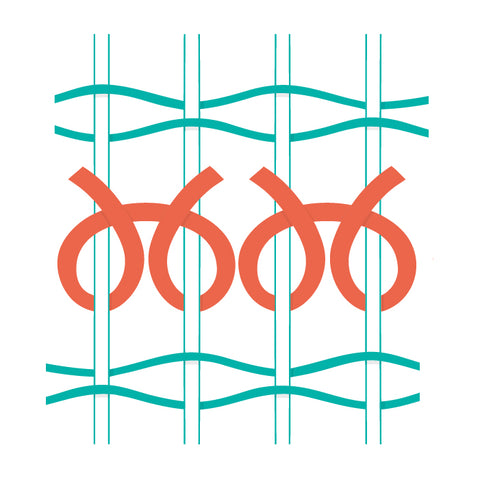
While more commonly associated with Turkish carpets, the Ghiordes knot has also been employed in certain Persian rugs, especially in areas closer to the Turkish border. This knot is symmetrical, with both ends of the yarn looping around two adjacent warp threads and emerging between them. This creates a more robust and dense pile, characteristic of rugs from areas like Heriz.
3. Jufti knot:
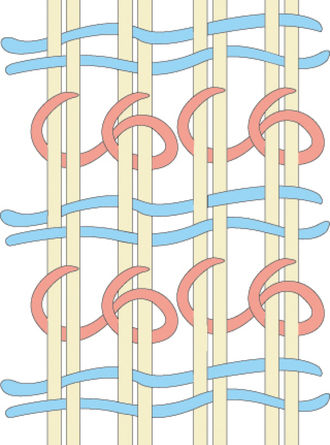
To speed up the weaving process, some carpets use the Jufti knot, which wraps around four (rather than two) warp threads. This technique results in half the knot density and is typically seen in carpets that cater to a more commercial market given their quicker production time. However, the reduced knot count can sometimes compromise on the rug's durability.
4. Tibetan knot:
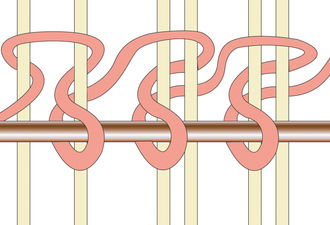
Though it originates from the Tibetan carpet tradition, this knotting style has influenced certain Persian carpet-making techniques, especially in regions influenced by Tibetan culture. Unlike the continuous weaving of the Senneh or Ghiordes knots, the Tibetan knot involves looping yarn around a rod, which is then removed to create a series of loops. These loops can either be left intact or cut.
The nuances of knot density
Beyond the types of knots, an essential factor in assessing a Persian carpet's quality and craftsmanship is the knot density—often measured as 'knots per square inch' (KPSI).
A higher KPSI typically indicates a carpet of superior quality, as the increased number of knots allows for more detailed designs and a more durable weave. However, the type of knot, materials used, and intended design can all influence the ideal knot density.
Types of Persian carpets
1. Tabriz carpets:
Hailing from the historical city of Tabriz in Northwestern Iran, these carpets are known for their exceptional quality and fine craftsmanship. Typically featuring medallion designs, hunting scenes, or historical narratives, Tabriz carpets often use a combination of cut pile and flatweave techniques, setting them apart from other styles.
2. Isfahan carpets:
Originating in the central Iranian city of Isfahan, a historic center for art and architecture, these rugs are renowned for their symmetrical patterns and central medallion designs. With high knot densities and a harmonious blend of vibrant colors, Isfahan carpets often incorporate intricate floral motifs, making them a favorite among collectors.
3. Kashan carpets:
Kashan carpets, named after the city of Kashan, are famous for their deep red hues and elaborate central medallion flanked by intricate arabesques and floral motifs. Often framed by a pronounced border, these carpets are timeless classics, loved for their elegance and sophistication.
4. Qum carpets:
Produced in the holy city of Qum, these are often crafted from silk, making them exceptionally fine and lustrous. Their designs range from intricate central medallions to elaborate garden scenes, and they are highly prized for their exquisite detailing and sheen.
5. Kerman carpets:
From the southeastern region of Kerman, these rugs are notable for their soft pastel hues and spacious patterns, often featuring garden, tree, or animal motifs. The unique attribute of Kerman carpets is their "vase technique", where vases filled with flowers and plants are woven into the design.
6. Hamadan carpets:
Produced in the Hamadan region, these are among the most durable of Persian carpets. Characterized by a thick pile, tribal patterns, and a rustic aesthetic, Hamadan rugs often employ geometric motifs and are typically framed by a simple border.
7. Nain carpets:
Known for their low knot count and high-quality wool and silk blends, Nain carpets feature intricate central medallions set against a cream or ivory background. The detailing, often in shades of blue, sets them apart.
8. Bijar carpets:
Originating from the Kurdish town of Bijar, these carpets are nicknamed "The Iron Rugs of Persia" due to their exceptionally robust construction. Their tight weave, coupled with rich, jewel-toned colors and geometric designs, makes them highly sought after.
Style and classic pattern of the Persian carpet
Persian carpets, renowned for their intricate designs and timeless appeal, are a testament to the rich cultural tapestry and artisanal heritage of ancient Persia. These carpets, often seen as more than just floor coverings, carry with them stories, legends, and the history of a people who have prized artistry and symbolism in every weave. The style and classic patterns found in these rugs are deeply rooted in tradition, yet they remain universally admired for their beauty and intricacy.
Central Medallion
At the heart of many Persian carpets lies the central medallion, a symmetrical focal point around which the rest of the carpet's design revolves. This medallion, which can be ornate and multifaceted or simple and understated, often symbolizes a spiritual or cosmic theme and is flanked by corner spandrels and surrounded by a field replete with intricate motifs.
Garden Paradigm
Drawing inspiration from the ancient Persian love for gardens and nature, this pattern encapsulates a bird's eye view of paradise on earth. Divided into rectangular sections that resemble individual garden plots, each section teems with floral motifs, wildlife, and flowing water channels, representing the gardens of heaven.
Hunting Scenes
Historical narratives and courtly activities frequently adorn Persian rugs. Among them, hunting scenes, with elaborately depicted hunters, prey, and natural elements, narrate tales of bravery, valor, and the relationship between man and nature.
Tree of Life
A profound symbol across many cultures, the Tree of Life in Persian carpets embodies life, growth, and eternal continuity. Branching out with birds, blossoms, and beasts, this motif signifies a deeply rooted existence and an ever-reaching aspiration towards the divine.
Herati Pattern
This repeating pattern, named after the town of Herat, consists of a floral rosette surrounded by leaves and vines, often encapsulated within a diamond or a curvilinear fish shape. This pattern, with its tight weave of symbolism, often covers the entire field of the rug.
Shah Abbasi Motifs
A tribute to the grandeur of the Safavid Dynasty, the Shah Abbasi motif features large palmettes and floral elements. The grandiosity of the design reflects the opulence and sophistication of Persian courtly life during the Safavid era.
Boteh or Paisley
This droplet-shaped motif, recognized globally as the 'paisley', has deep roots in Persian carpet design. Boteh, which can symbolize life, growth, and eternity, has been adapted and evolved in various cultures but remains a staple in Persian rug patterns.
All-over Pattern
Instead of a central medallion or distinct border, some Persian carpets employ an all-over pattern, creating a harmonious and unifying theme. These patterns can range from repeating geometric motifs to a dense, intertwined flora and fauna.
Persian carpets in literature, cinema and music
Literature
The ethereal beauty and intricate craftsmanship of Persian carpets have been the subject of admiration in literary works across the globe. One cannot forget the magical flying carpet tales from "One Thousand and One Nights", where these rugs transcend their material form to become objects of wonder and transportation.
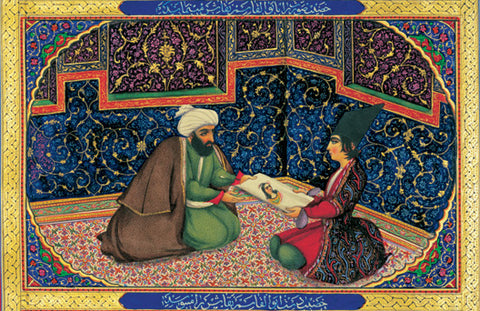
Poets like Omar Khayyam and Rumi, in their verses, have often alluded to the carpet's weave as metaphors for life's complexities, fate, and divine craftsmanship.
Cinema
In film, the Persian carpet often takes on symbolic dimensions. Consider, for example, the 1996 Iranian film "Gabbeh," directed by Mohsen Makhmalbaf. The narrative revolves around a type of Persian rug known as a 'gabbeh', and through it, tells a compelling story of love, tradition, and the nomadic life of the Qashqai people.
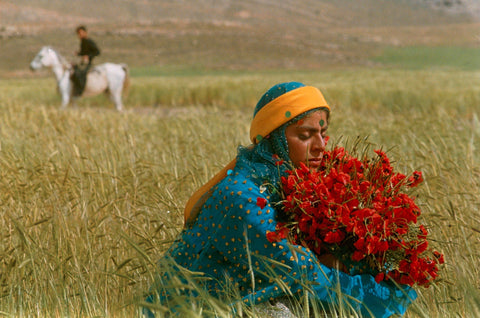
In Western cinema, Persian rugs are often associated with luxury, exoticism, and opulence, decorating palaces and rich households, hinting at the inhabitants' wealth and taste.
Music
The intricate designs and stories woven into Persian carpets have also found echoes in music. In classical Persian music, the carpet serves as more than just a decorative piece; it is an essential part of the setting where musicians sit and perform. The texture and material of the carpet can even influence the acoustics of the performance. Beyond this functional aspect, the carpet has been a metaphor in many Persian songs, symbolizing the groundwork of life, memories, and history that lays beneath our feet, often taken for granted but ever significant.
Modern References
In contemporary literature and pop culture, Persian carpets have come to symbolize a myriad of themes. They're often used as metaphors for intricate stories, where each thread tells a tale, much like the complex plots of modern novels. In music videos and films, they symbolize luxury, tradition, and sometimes, the mystical and unknown. The flying carpet trope, popularized by tales of Aladdin, continues to be a symbol of escape, adventure, and magic.
Similarities and differences between Persian carpets and the Azerbaijani school of carpet weaving
Both Persian and Azerbaijani carpets are steeped in rich history, with each boasting distinct characteristics and an inherent charm that has garnered global admiration. These woven masterpieces, born from the ancient cultural tapestries of Persia and Azerbaijan, share similarities, yet they also diverge in intriguing ways. Let’s delve into the nuanced world of these carpets to uncover their shared heritage and their unique identities.
1. Similarities:
- Rich History: Both Persian and Azerbaijani carpets have deep roots dating back centuries. These rugs are more than mere decorative items; they're embodiments of tales, traditions, and the spirit of their people.
-
Artistic Expression: Both types of carpets are characterized by their intricate designs, elaborate motifs, and the skilled craftsmanship that goes into weaving each piece.
- Materials Used: Common materials in both traditions include wool, cotton, and silk, which are dyed using natural ingredients to achieve vibrant, lasting colors.
-
Symbolism: Both carpets often incorporate motifs and symbols that carry specific meanings, ranging from life, prosperity, and nature to stories from folklore.
- Knotting Techniques: The Persian and Azerbaijani weaving schools employ similar knotting techniques, with the symmetrical (Turkish) knot being prevalent.
2. Differences:
- Design Patterns: While both carpets are known for their intricate designs, the motifs and patterns can differ. Persian carpets often feature centralized designs like medallions, while Azerbaijani rugs might employ more repetitive, allover patterns or feature stylized depictions of daily life.
- Geometric vs. Floral: Azerbaijani carpets tend to lean more towards geometric designs, possibly reflecting the country's Turkic influences. Persian carpets, on the other hand, often incorporate more floral and curvilinear patterns.
- Colors: The color palettes, while both vibrant, can differ. Azerbaijani rugs might favor more earthy tones and primary colors, while Persian carpets are known for a wider range of colors, including indigo, ruby red, and rich golds.
- Regional Variations: Just as Persian carpets have variations based on the region (like Tabriz, Isfahan, or Qom), Azerbaijani carpets too have regional differences, such as Karabakh or Shirvan, each with its unique style.
- Cultural Influence: The designs of Azerbaijani carpets are significantly influenced by the nation's Turkic heritage, while Persian carpets often showcase the influences of various dynasties that ruled Persia, from the Safavids to the Qajars.
Can Persian carpets be called Azerbaijani?
The world of carpets is as diverse and intricate as the patterns woven into their fabric. At the intersection of this vast universe lie the Persian and Azerbaijani carpets, both celebrated for their beauty, craftsmanship, and cultural significance. But can Persian carpets truly be termed Azerbaijani, and vice versa? Let's draw our threads of understanding together.
First, it's essential to appreciate that both Iran (historically known as Persia) and Azerbaijan have robust carpet-making traditions that span centuries. Geographically adjacent and historically intertwined, their shared experiences, trade, migrations, and conquests have allowed for a rich exchange of ideas, techniques, and styles in the realm of carpet-making.
Persian carpets, often characterized by their intricate designs, rich color palettes, and specific regional patterns, have been globally recognized and sought after. They embody the essence of various regions within Iran, each with its own unique style— from Tabriz to Kashan, from Isfahan to Qom.
On the other hand, Azerbaijani carpets, with their distinct geometric patterns, vibrant colors, and deep-rooted cultural motifs, tell the tales of Azerbaijan's regions—like Karabakh, Shirvan, and Ganja. Azerbaijani carpets, too, have their own place of honor and are recognized for their distinctiveness and artistry.
So, while there are shared motifs, techniques, and influences—owing to their intertwined histories and proximities—Persian and Azerbaijani carpets remain distinct entities. Each stands as a proud testament to its own region's artistry, history, and cultural narrative.
In essence, calling a Persian carpet "Azerbaijani" or vice versa would be an oversimplification, akin to painting two distinct art forms with the same brush. It's imperative to celebrate and respect the uniqueness of each, even as we appreciate the shared legacies and influences that weave them together.
Thus, while they share a rich tapestry of history, and the lines might blur at times, Persian carpets should be recognized and celebrated for their Persian roots, just as Azerbaijani carpets should be honored for their Azerbaijani heritage. The beauty lies in both their distinctions and their shared chapters in the grand narrative of carpet-making.


